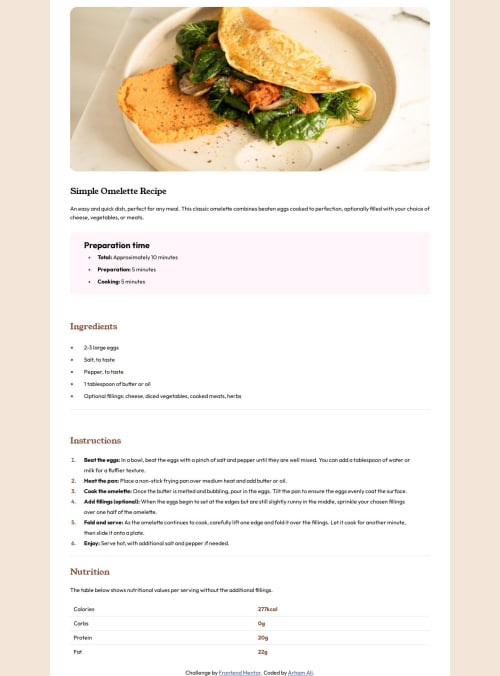Recipe Page – Built with HTML, CSS, and Responsive Design Techniques

Solution retrospective
I’m most proud of successfully implementing a responsive recipe page with a clean and structured layout using only HTML and CSS. The use of custom fonts, CSS variables, and semantic HTML ensures both readability and maintainability. Additionally, I ensured that the design remains visually appealing across different screen sizes with media queries.
What would you do differently next time? Next time, I would:
Improve interactivity by adding JavaScript features like a dark mode toggle or a checklist for ingredients.
Enhance accessibility by using ARIA attributes and improving keyboard navigation.
Optimize for performance by lazy-loading images and minimizing CSS.
Explore animations for a smoother user experience, like hover effects on list items.
What challenges did you encounter, and how did you overcome them?-
Responsive Design Adjustments Challenge: Ensuring the layout remained consistent across different screen sizes, especially on mobile devices. Solution: I used CSS media queries to adjust the layout for smaller screens, ensuring images and text resized properly. I also made the main container fluid (80% width on larger screens and full width on mobile) for better responsiveness.
-
Custom Fonts Not Loading Properly Challenge: Initially, the custom fonts (YoungSerif and Outfit) didn’t display correctly. Solution: I checked the file paths and ensured the @font-face declaration was correctly linked to the font files. I also provided fallback fonts in case the custom ones failed to load.
-
List and Table Styling Issues Challenge: The bullet points and table layout didn’t look visually appealing at first. Solution: I used ::marker to style list items and nth-child selectors to customize table rows, improving readability and structure.
-
Maintaining Clean & Reusable CSS Challenge: Managing colors and typography without duplicating styles. Solution: I implemented CSS variables (:root) for colors and font sizes, making the styles easier to manage and update in the future.
- Code Optimization & Best Practices Are there any redundant CSS styles that could be simplified or improved for better maintainability?
Any suggestions for optimizing the HTML structure to make it more semantic and accessible?
- Enhancing User Experience (UX) & Interactivity What JavaScript features could enhance usability, such as an ingredient checklist or a dark mode toggle?
Would adding smooth transitions or animations improve engagement, and if so, where should they be implemented?
- Performance Optimization Are there performance improvements I can make, such as lazy-loading images or reducing CSS file size?
Would using CSS Grid instead of Flexbox for layout be a better approach in this case?
- Accessibility Improvements How can I improve keyboard navigation and screen reader support for a more inclusive experience?
Please log in to post a comment
Log in with GitHubCommunity feedback
- @Le-Joker
TRES INSTRUCTIF
Join our Discord community
Join thousands of Frontend Mentor community members taking the challenges, sharing resources, helping each other, and chatting about all things front-end!
Join our Discord